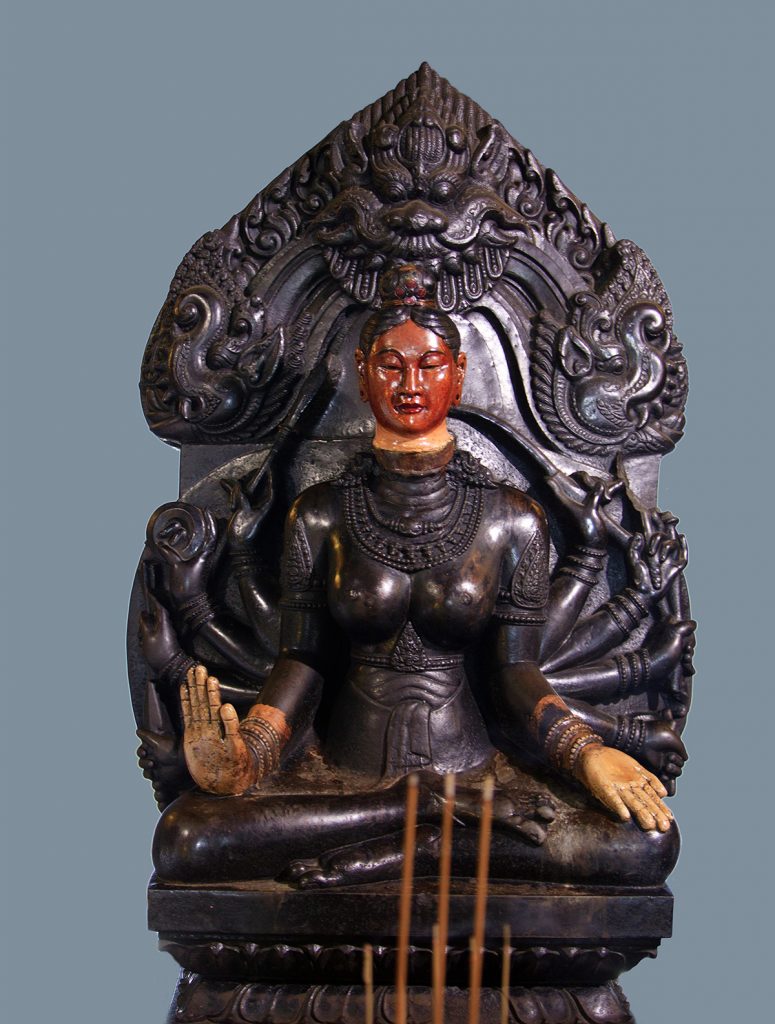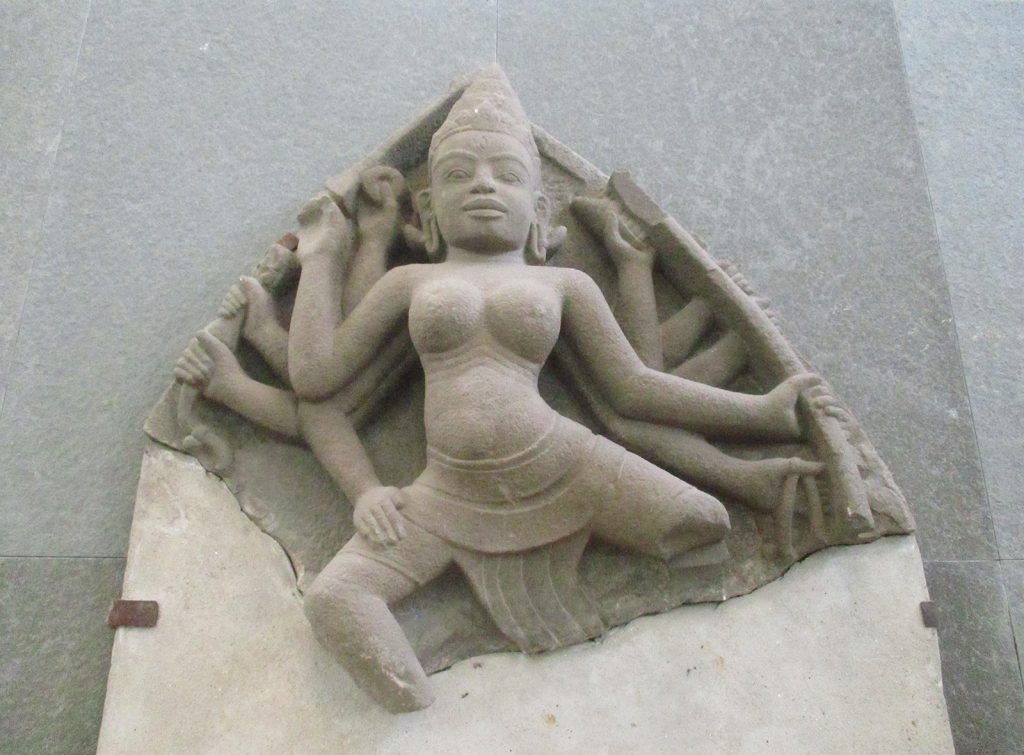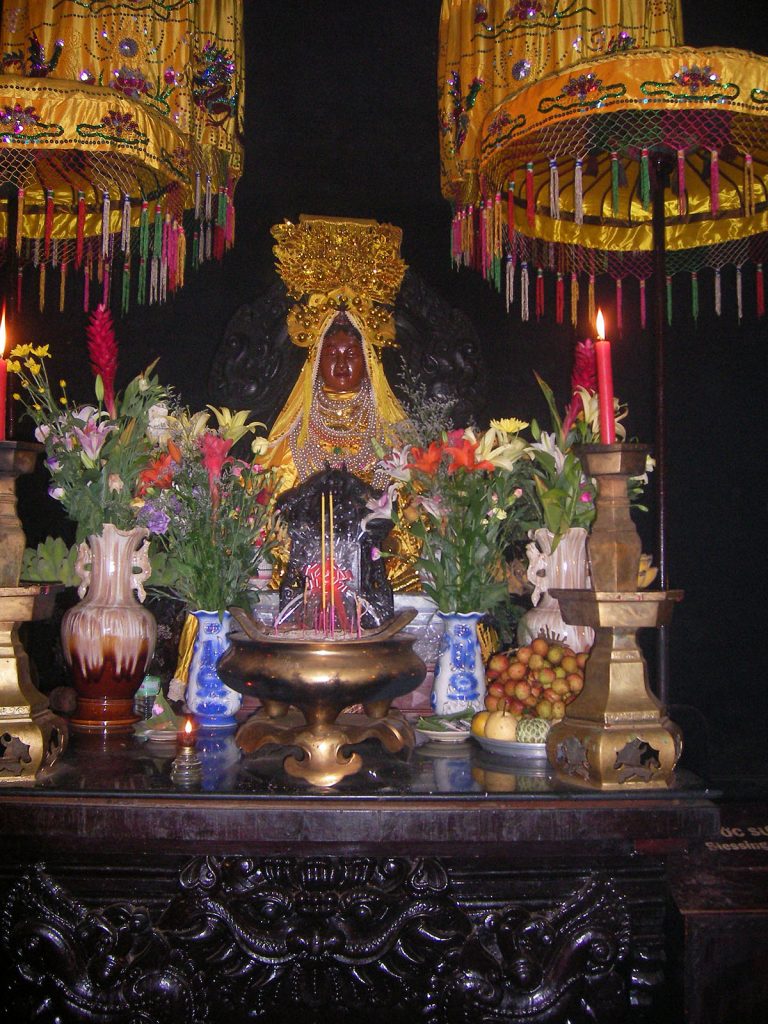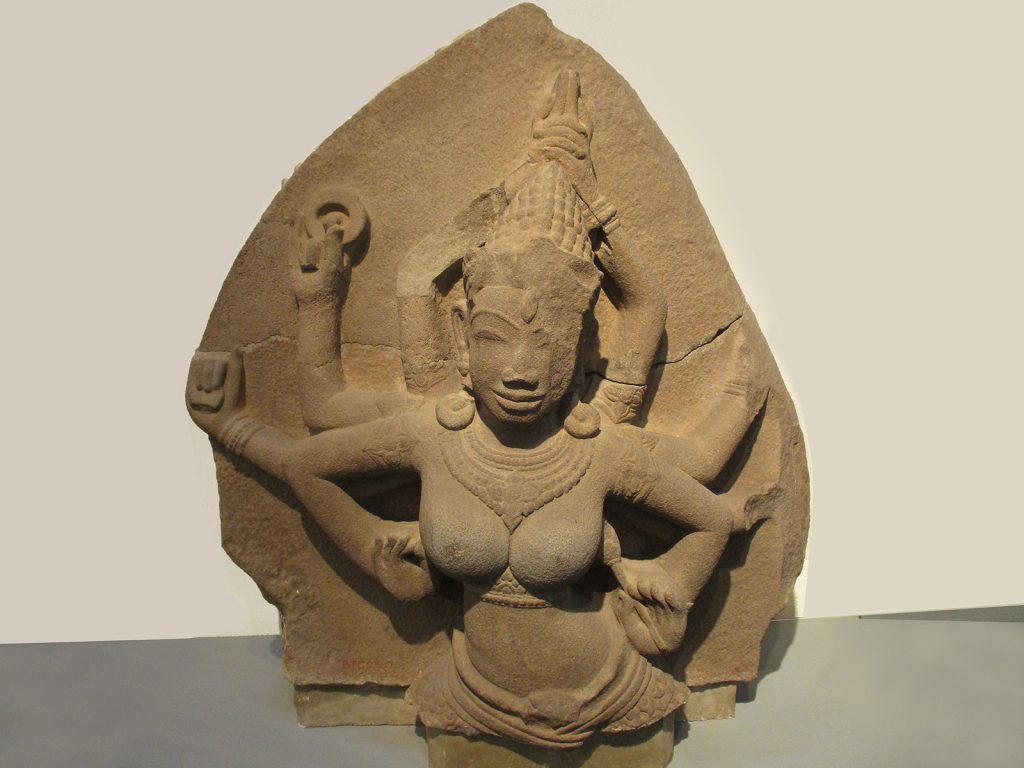Volume 1, Issue 4, September–October 2020.
The Mysterious Durga Statue
of Thap Ba Temple
Prof. Dr. Ngo Van Doanh
King Sri Indravarman III installed a golden image of the goddess Bhagavati at the Thap Ba Temple in 918 CE, we are told by a stele inscription at Po Nagar:
In the year of the Sakas denoted by ‘vyoma-amburasi-tanu’ [840 Saka], on Sunday, the eleventh day of the dark fortnight of the month of Suci [Jyaistha or Asadha], he [Indravarman III] installed a golden image of the goddess Bhagavati in order to gain fame around the whole world. The inscription also praises King Indravarman:
King Sri Indravarman, skilful in protecting Champa, was like a full moon in the sky. He who [skifully played in the] good waves that are the six systems of Philosophy beginning with Mimamsa and those of Jinendra [ieBuddha], and in the mass of water which was [Panini’s] grammar with Kasika, who was a fish [in the water] which was the Akhyaca and the Uttarakalpa of the Saivas; because among the learned, he was the most skilful in all these subjects. 1
However, the golden image of the goddess Bhagavati unfortunately sat only very briefly on the altar at the temple at Po Nagar. More than 30 years later, in 950, the golden image was removed and destroyed. The Po Nagar stele inscription of Jaya Indravarman I, dated 887 Saka [965 CE] tells us that:
The golden image which was formerly installed by [the king], of a majesty difficult to attain, the Kambujas, dominated by cupidity and other vices, carried [it] away and destroyed [it]… In the year of the Saka king denoted by ‘adrriasta-anga’ [887 Saka, 965 CE]. Sri Jaya Indravarman again installed a stone image of the goddess in Kauthara, for the sake of glory.2
In short then, the inscription records that in 965 C.EKing Sri Jaya Indravarman installed a stone image of Bhagavati to replace the golden one installed by King Sri Indravarman, since the latter had been carried off by the Cambodians. This shows that between 918 and 965 C.E., Champa was conquered by a Cambodian king. This inference concurs with the Baksei Cankran and Prasat Bat Chum inscriptions of Rajendravarman II (944-968 C.E.) according to which this Cambodian king conquered the kingdom of Champa. According to Cambodian inscriptions, a Cambodian army invaded Champa and destroyed its capital:
The extent of his splendor, like the fire of universal destruction, burning the enemy kingdoms, beginning with Champa … the city of the King of Champa, having the sea for its moat, was reduced to ashes by his warriors, obedient to his orders.3
From this time on, the Champa inscriptions tell us nothing more (regarding destruction or damage) of the stone image of Bhagavati that had been installed by King Sri Jaya Indravarman in 887 Saka (965 C.E.). So, we cannot be certain whether or not the great stone statue of the goddess now standing in the central Thap Ba Temple, which the Vietnamese generally refer to as Thien-Y-A-Na, is in fact the stone image of Bhagavati installed in 965 C.E. Even at the beginning of the twentieth century, whilst he researched the remains of the Po Nagar temple, the French scholar Henri Parmentier thought that the statue worshipped in the central temple-tower might have been the Bhagavati Uma statue that had been erected in 887 Saka (965 C.E.).4 However, nearly 40 years later, in 1942, the stone statue of the central temple-tower was carefully analysed by another French scholar, P. Stern, who noted that the style analysis indicated that the base of the statue had an ogival stele that predated the statue (belonging to the early period of the My Son A1 style) and that given the stylistic mismatch it might well have been re-erected in the middle of the eleventh century.5 In 1963, more than 20 years later, the French scholar J. Boisselier continued work on the statue in the central temple, specifically analysing all decorative designs on the stele, especially the Kala head at the top and the two Macara heads on either side of the stele arch, J. Boisselier considered all the decorations on the stele to belong stylistically to the My Son A1 period. As P. Stern had concluded after his analysis of the decorative spear-shaped flowers on the body belt and bracelets, Boisslier felt that the statue might belong to the late period of the My Son style, a little bit later than 965.6
The statue in the central tower at Thap Ba Temple is quite large (90cm tall) and has been carved together with the stele behind it from a single stone block. The goddess sits in virasara (right leg is placed on the left one) with two outstretched hands resting on the knees in the dispensation of sacrament: the upward palm of the left hand on the left knee in abhaya mudra, and the upward palm of the right hand resting on the right knee in varada mudra. In addition to these two main hands, the goddess has eight minor hands (four on either side) that clasp in their palms Siva’s attributes: sword, arrow, club and spear in the right hand; bell, plate, bow and conch in the left.
Researchers have concluded that with these attributes typical of the god Siva, the goddess in the central temple-tower is Durga. In the legends, Durga is often considered to be a courageous and fearsome combatant, a goddess who protects gods and the order of the universe from the threats of wild devils. One of the great military achievements of the goddess is the destruction of the cruel, buffalo-headed devil Mahisha who cast gods down from heaven into the world. Popularly, under the title of vanquisher of the buffalo-headed devil, Durga is manifested as a Goddess with 10 hands sitting upon a lion or tiger and holding various weapons and symbols of the gods such as the trident of Shiva, the plate of Vishnu, the bow of Vayu the wind god, the spear of Agni the fire god, the plate of Indra the thunder god, and the chord of Varuna the sea god.
The goddess wears only a skirt with the central flap folded over. According to J. Boisslier, the style of dress of the Durga goddess in the Thap Ba Temple resembles that of the statue of Sri from Tra Kieu (early period of My Son A1 style).7 All the upper body and the two main hands of the goddess are beautifully expressed: the breasts are heavy, beneath them there are two deeply-incised-flesh folds. However, according to my own study, the breasts are heavily modelled, and beneath them there are three deeply-incised flesh folds, popular features for female deities in the late Dong Duong period (circa tenth century). We can see these features in the unidentified female deity from Dong Phuc, Quang Ngai (Da Nang Museum, height 64cm, the unidentified female deity from Phu Nhan, Quang Ngai (Da Nang Museum, height 96cm, and the bronze female deity (Laksmindra-Lokesvara?) discovered in 1978. The jewellery consists of a breast belt, necklace and upper armlets. These accessories mostly consist of rows of beads decorated with triangular flowers. Researchers have concluded through their analysis that this kind of jewellery is a typical feature of the early My Son A1 period. Unfortunately, the head of the goddess has been lost. So, in the absence of the original head, the statue has lost some of its beauty and solemnity. The stele behind the statue (height 1.70m, width 1.05m) is also decorated with beautiful motifs and designs. The front side of the stele has been represented as a Kala-Makara-Torana (the kind of arch that consists of a Kala head at the top and two Macara heads on the two lower sides). The results of the style analysis allow us to infer that the Kala and Macaras of Po Nagar (central temple) have many of the characteristics of the Tra Kieu style (early My Son A1 period): Kala has no lower jaw, no rings hung from the teeth; Macara has a rolling trunk, some big fangs in the upper jaw, round eyes, raising funnelshaped ears, big fire-shaped design in the head.8
The rear of the stele was emphasised by an arch and a length of decorative band. The arch consists of a round flower with an acute upper end at the top and four big flame-shaped motifs (two on either side). This kind of arch appeared and became popular during the Dong Duong style (second half of the ninth century). However, the round flower with an acute upper end that supports a flame motif on the stele has been surrounded by the line of the arch, a typical feature of early My Son A1 period (the beginning of the tenth century). Moreover, the decorative worm-shaped plant on the long band resembles the sculptural design of My Son A10 templetower (early My Son A1 period).
So, based on an analysis of the style, we can define the stone Durga statue at the Po Nagar Temple as being in the My Son A1 style, and date it to the tenth century. From this conclusion, we can also posit that the present stone Durga statue at the temple at the Po Nagar Temple is the same stone statue that was erected by the king Sri Jaya Indravarman in 965 C.E (887 Saka). The entire statue and the stele behind it has been placed on the big stone square Yonishaped pedestal (width 1.50m, height: 0.30m) with a long gutter (1.76m). The Yoni pedestal has been laid on a large square stone consisting of three blocks (width 0.90m, height 1.95m). The stone Durga statue erected by King Sri Jaya Indravarman in 965 C.E is still a central worshipping statue at the Po Nagar Temple, and one of the most beautiful sculptural masterpieces of art from Champa.
Notes
1 R. C. Majumdar, The Inscriptions of Champa, Gian Publishing House, Shakti Nagar, Delhi, 1985, p. 139.
2 R. C. Majumdar, The Inscriptions of Champa, Gian Publishing House, Shakti Nagar, Delhi, 1985, p. 144.
3 Lawrence Palmer Briggs, The Ancient Khmer Empire, American Philosophical Society, Philadelphia, 1951, p. 126.
4 H. Parmentier, Inventaire descriptif des monuments Chams de L’Annam (IC.); Paris, 1909, T.I, Po Nagar.
5 P. Stern, L’art du Champa et son evolution, Toulouse, 1942, p,108.
6 J. Boisslier, La statuaire du Champa, EFEO, Paris, 1963, pp. 207-208
7 J. Boisslier, La statuaire du Champa, EFEO, Paris, 1963, p. 187.
8 J. Boisslier, La statuaire du Champa, EFEO, Paris, 1963, p. 204.





